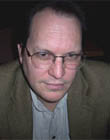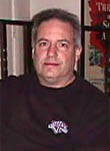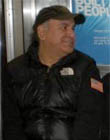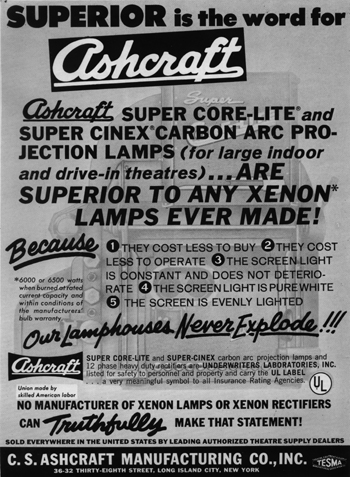|
|
This topic comprises 2 pages: 1 2
|
|
Author
|
Topic: Seeking information on old projector equipment
|
Michael Kenney
Film Handler
Posts: 5
From: Jamestown, NY USA
Registered: Jun 2008
|
 posted 06-23-2008 06:55 AM
posted 06-23-2008 06:55 AM




Hello. As this is my first official post on this forum, I think I should introduce myself. I am not a projectionist or cinema employee, but rather a person who is researching an old theater in his town. I am doing this in the hopes that we can someday save and restore the theater. For the time being, I am trying to research all I can about the theater and have that information on hand to produce a short documentary about it, the men behind it and it's history up until it closed it's doors officially in 1991.
As part of my research, I have been allowed access into the theater, and I have seen the projection equipment in the projection house. I've learned a lot over the course of the last couple of weeks, but *know* I still have a lot to learn.
A little of what I have learned is that the theater was built and opened for business on Christmas Eve, December 24th, 1913. Although built for both Vaudeville and movies, I don't believe the theater ever featured vaudeville acts, as all of it's advertising for much of it's early years only featured "photoplays" and movies. What kind of projection equipment would have been used back in 1913? I am not sure, but would love to hear suggestions. Sadly, information on projectors is limited online, and it's difficult to research.
In 1927, it was the first theater in my town that featured a "talkie", Al Jolson's "The Jazz Singer". Obviously, newer equipment was probably installed to accomplish the presentation of this now classic film.
In 1950, the theater, now under ownership by Warner Brothers, was completely remodeled. The old box seats, fly space above the stage, plaster decorative work, wood and brass were gutted, and a straight forward movie house was born. The original marquee was replaced with a 'modern' neon marquee that was very popular for the time, and the street level facade was covered in a sheet metal (streamline-esque) facing that covered up the old terra cotta and brick work. I believe it was around this time that the current projectors were installed.
There are only two in the projection booth. Both projectors have Ashcraft Suprex C70 Carbon Arc lamp houses. I haven't found any material about these particular model lamp houses, but I have learned quite a bit about Carbon Arc systems. This is a big movie theater, so a very strong light source would be needed considering the distance from the projectors to the screen. I understand the basic concept of the carbon arc system. But have not seen one in actual use yet (well, not counting watching movies).
Projector #1 has a Brenkert BX-100, while projector #2 has an RCA-100. My belief is, these are the same, just one was manufactured for RCA with the RCA logo and model number, the other one only mentioned Radio Corporation of America on it's Patent plate. These both seem to be in good shape, considering their lack of use for 17 years.
The soundheads are both RCA 9030 soundheads, and projector #2 also has a box that reads "Magnetic Soundhead MI-9010" and it sits atop the projector, while the 9030 sits below. I'm not sure what this is for. As I said, I still have much to learn.
Last but not least are the IPC Simplex... I want to call them canisters, but I know this isn't correct... for the source and take up reels.
The screen is an XR-171 made by Technikote Corporation. I found an address and phone number, but learned they recently went out of business. I did find a company called Xetron (neumade) that bought up Technikote's business, and still apparently sells that screen. Unfortunately, I don't think they would be able to tell me when they installed the screen or even what aspect ratio is it. My guess is 1.85:1, (based on a photo I took and measured out in Photoshop) but I have been told by a former manager that the screen is supposedly a true Cinemascope screen, the only one ever in town. If that is true, I would have expected the screen to have a slightly wider shape to it, wouldn't it? There is a concave curve to the screen, so I can't say for sure that my estimates are correct. Sadly, the screen has 3 holes (fist size) in it, and it's been exposed to 17 years of moisture (indirect, not directly on the screen), neglect and age. I doubt the screen is in any kind of useable condition anymore, but I could be wrong.
I have been told the projectors could be refurbished and have a new life, but for a movie theater, I think their time has come and gone. Considering the advances in projection technology, and sound, I have my doubts they could be used for current films. I would love to know anyone's thoughts on this, any information they could share on the various components I have listed here, and their opinions on the projectors themselves.
I admit am completely a novice, but I've learned enough that I want to know more. What was first a project to learn some history about a local old theater, has now become something much larger for me. I have a new appreciation for film presentation that I never had before, and I realize there is a lot of skill, care and dedication needed to be a projectionist.
I guess it's all part of the magic, isn't it? ![[Smile]](smile.gif)
| IP: Logged
|
|
|
|
|
|
Michael Kenney
Film Handler
Posts: 5
From: Jamestown, NY USA
Registered: Jun 2008
|
 posted 06-23-2008 12:39 PM
posted 06-23-2008 12:39 PM




Thank you Martin, for your quick thoughts. I look forward to hearing more from you when you have more time. ![[Smile]](smile.gif)
From what I can determine, the owners who built this theater never wound up bringing in vaudeville acts, unless they were enticements to stay for 'photoplays'. I spoke to someone recently (a wonderful lady who is now 90 years old and was married to the son of the original theater owner) who told me they used to bring in live animals and strong man acts as part of the movie showing, either before or after the show. I'm not sure however, if these were true Vaudeville acts.
I do know these kind of promotions continued well into the 50's. I have a scan of an old B&W photograph from 1952 taken in front of this theater that shows a promotional event for an MGM film "The Wild North" which featured a sled-dog team complete with a driver dressed in an eskimo parka.
The owners opened another theater in town specifically for Vadeville and movies only 10 years after this one was opened. And that one was confirmed to have had Vaudeville acts up until the 1930's. I think (though I can't confirm this) the owners wanted to separate the two entertainment styles for some reason, between the two theaters. Thankfully, I am in contact with a gentleman who knew the original theater owners from the time he was 10 years old. He will be visiting my town next month and I'll be interviewing him for sure. His mind is still sharp as ever, and he can remember things back to when he was 2 years old, so his recollections of the theater I'm researching are, in my opinion, priceless.
The theater auditorium is quite large, and when it was constructed, it did have electricity installed, and specifically had a booth called the Lamp House in the original blueprints. I'm not sure a hand cracked projector would have been okay for that sized theater, but I'm still only learning about the technology of the day. I'm hoping to expand my knowledge in this area, and with any luck, maybe run across a gem of information that will answer that question of which projector was used 95 years ago in that theater. Stranger things have happened.
Yes, these projectors are mix & match. I also think they could be serviced and refurbished to run again, but considering their age and how far advanced film tech has become, I doubt there would be little point in doing this other than for a museum piece or display. I would love to see the publicity photo you have if you can post it sometime. Thank you. ![[Smile]](smile.gif)
Yes, I have had an amazing time researching this theater. When I started this endeavor over a year ago, it was little more than an effort to learn something about the theater that we could use in the purchase of it for a theater group I'm a part of. Sadly, our group has passed on doing that, but I'm still fascinated by this theater. I've been inside it about 4 times now over the last 2 months, and every time I go in, I get this amazing overwhelming sense that the old girl has some life left.
If I had my way (and a significant amount of investment capital) I'd love to renovate the theater into a multi-function entertainment complex, keeping touch with it's theater roots with a redone, somewhat smaller theater, updated system (digital of course), with much more. With the price of gas continually going higher, and people starting to cut back on needless expenses, they're less likely to drive out to a theater when there could be one a short walk away. At least that's what I keep telling myself. Maybe it's a pretty big dream... but "where is it written that all of our dreams must be small ones?"
| IP: Logged
|
|
|
|
|
|
|
|
|
|
Tim Reed
Better Projection Pays

Posts: 5246
From: Northampton, PA
Registered: Sep 1999
|
 posted 06-23-2008 01:13 PM
posted 06-23-2008 01:13 PM




Michael, you've done your homework well. ![[Smile]](smile.gif)
AFAIK, Ashcraft didn't make many Suprex-style lamps, although the C70s were moderately popular in their day. Ashcraft was better known for the larger, rotating positive, water-cooled lamphouses as used in drive-ins and large indoors.
Like Mitchell said, your theatre could've had anything for equipment in the silent days.
The mag penthouse was for, surprisingly enough, films with magnetic stereo soundtracks, which began with CinemaScope in '53. Goodness knows what happened to the penthouse from the other machine. It's probably still there somewhere.
The Simplex reel magazines (IPC = International Projector Corp.) may have been left over from a prior Simplex installation. The RCA stuff was probably installed when they did the CinemaScope and stereo conversion. The BX-100 dates from the early 50s, so it follows that your place had a third equipment roster between the silent days and CinemaScope. This can often be confirmed by the presence of old parts in the booth that don't go with any of the current equipment.
FWIW, the fact that the two projectors don't match (although they are the same model) suggests that one was removed for repair at some point and replaced with another.
Good luck! You're off to a great start.
| IP: Logged
|
|
|
|
Michael Kenney
Film Handler
Posts: 5
From: Jamestown, NY USA
Registered: Jun 2008
|
 posted 06-23-2008 02:22 PM
posted 06-23-2008 02:22 PM




Mitchell: Thanks for the information. I did find a bunch of information online (through this website and a couple others) about Cinemascope, but knowing the year helps immensely. The screen is slightly curved, so it could very well be a Cinemascope screen. Hopefully I'll be able to find out more. In fact, I just got a call back from Nuemade with a contact number for someone who could help me with information about Technikote Corporation screens, so if luck is on my side, I'll know a lot more shortly.
Bill: Wow, I never knew about those yearbooks. Thank you! From what I gathered online, the Film Daily Yearbooks ran from 1915 until 1970, is that correct? Do you know if there any way I could get ahold of these invaluable guides for some additional research?
Jack: Thanks for your insights. Ironically, there are boxes of unused arc carbons still in the projection booth. 7mm and 8mm were both used if I'm not mistaken, one for positive and the other for negative, yes? There are a lot of speakers. Unfortunately, I can't seem to find an amplifier system....yet. (probably buried backstage or hidden in one of the rows of seats somewhere.) The years of exposure though, make me wonder if they any good anymore. Thanks again!
Tim: Thanks! I'm nothing if not curious and persistent. These are definitely Ashcraft Suprex Carbon Arc lamps. I have pictures to prove this which I'll upload shortly. I researched the patent numbers on the model number plates to find the Carbon Arc patent written by Clarence S. Ashcraft. It's through that document that I learned the basic principle of Carbon Arc lighting. And just from an design aesthetic point of view, the housing just looks cool as hell, IMO. I am in agreement with you on the point of there having been other projection installations prior to this one. My guess is that there was one from 1913 until around 1927, then they installed a system for the talkies. I assume another setup was installed when the theater was renovated in 1950, and it's possible that's the basic system that we see now, with some modular improvements or replacement until the theater closed in 1991.
Carl: The reason I for a smaller auditorium would be simply due to the fact that where the theater is located, parking is not plentiful. There are 3 parking garages nearby, but 2 are 3 blocks or more away, and one is connected to a hotel, so it's full most of the time. A 1231 seat theater is simply not feasible without adequate plentiful adjacent parking. A smaller theater would be better, as it would make room for some additional business enterprises in the same building, related to the theater. I can't go into detail here, but it's simply an idea. As for the digital system, I want to keep a forward thinking view of this theater. I would love to have a standard film system but either way you slice it, I would have to look at purchasing a new projection and sound system, especially if it was to show first run films. If it stayed as an art house, the older system would be okay, but we already have 1 art house in town, and it makes no money, period. The idea is to make the property a self-sustaining business venture, while maintaining a connection to it's past. I think it can be done, slightly smaller than it currently is, but with more opportunity to make money and support itself. There are some who love the idea, and some who flatly disagree with me, locally. But we'll see how things go.
| IP: Logged
|
|
|
|
|
|
|
|
|
|
|
|
All times are Central (GMT -6:00)
|
This topic comprises 2 pages: 1 2
|
Powered by Infopop Corporation
UBB.classicTM
6.3.1.2
The Film-Tech Forums are designed for various members related to the cinema industry to express their opinions, viewpoints and testimonials on various products, services and events based upon speculation, personal knowledge and factual information through use, therefore all views represented here allow no liability upon the publishers of this web site and the owners of said views assume no liability for any ill will resulting from these postings. The posts made here are for educational as well as entertainment purposes and as such anyone viewing this portion of the website must accept these views as statements of the author of that opinion
and agrees to release the authors from any and all liability.
|

 Home
Home
 Products
Products
 Store
Store
 Forum
Forum
 Warehouse
Warehouse
 Contact Us
Contact Us




 Printer-friendly view of this topic
Printer-friendly view of this topic




![[Smile]](smile.gif)











